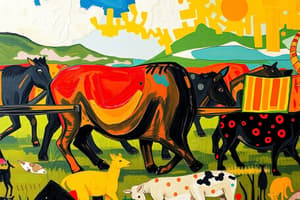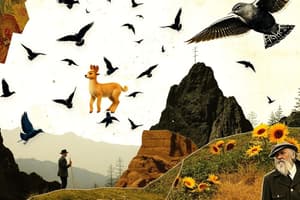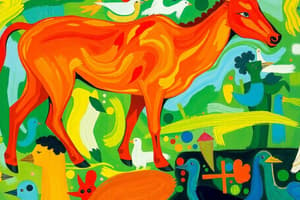Podcast
Questions and Answers
What is population density and how is it determined?
What is population density and how is it determined?
Population density is the number of individuals of a species per unit of area or volume at a given time, determined by biotic and abiotic factors in the environment.
Describe the three types of population dispersion.
Describe the three types of population dispersion.
The three types of population dispersion are random, clumped, and uniform. Random dispersion has individuals spaced unpredictably, clumped has individuals grouped together, and uniform has individuals evenly spaced.
What are the main factors that cause changes in population size?
What are the main factors that cause changes in population size?
The main factors are natality (birth rate) and mortality (death rate), along with immigration and emigration of individuals.
What does a positive population growth indicate?
What does a positive population growth indicate?
How does negative population growth affect the size of a species population?
How does negative population growth affect the size of a species population?
Explain what is meant by zero population growth.
Explain what is meant by zero population growth.
What potential does every species population have in terms of growth?
What potential does every species population have in terms of growth?
What are the implications of increased population density over time?
What are the implications of increased population density over time?
What is population ecology and how does it relate to the environment?
What is population ecology and how does it relate to the environment?
List four factors that cause changes in population size.
List four factors that cause changes in population size.
Define the intrinsic rate of increase in populations.
Define the intrinsic rate of increase in populations.
Contrast J-shaped and S-shaped growth curves in population studies.
Contrast J-shaped and S-shaped growth curves in population studies.
What are density-dependent factors in population ecology?
What are density-dependent factors in population ecology?
Describe Type I survivorship curves and their implications for mortality.
Describe Type I survivorship curves and their implications for mortality.
Summarize the characteristics that define a population in ecology.
Summarize the characteristics that define a population in ecology.
Explain the significance of carrying capacity in population dynamics.
Explain the significance of carrying capacity in population dynamics.
What primarily contributed to the recent increase in the human population?
What primarily contributed to the recent increase in the human population?
How does the growth rate of a population change when the birth rate equals the death rate?
How does the growth rate of a population change when the birth rate equals the death rate?
What is Earth's carrying capacity, and what factors influence its estimates?
What is Earth's carrying capacity, and what factors influence its estimates?
In the case of Mexico, what patterns are observed in the birth and death rates during the 20th century?
In the case of Mexico, what patterns are observed in the birth and death rates during the 20th century?
What is the trend in the global per capita growth rate from the mid-1960s to 2013?
What is the trend in the global per capita growth rate from the mid-1960s to 2013?
What effect does the accumulation of toxic waste have on population growth?
What effect does the accumulation of toxic waste have on population growth?
Define density independent factors and give two examples.
Define density independent factors and give two examples.
How does temperature influence populations in an ecosystem?
How does temperature influence populations in an ecosystem?
Explain how light intensity impacts the distribution of organisms.
Explain how light intensity impacts the distribution of organisms.
What role does water play in supporting population sizes in aquatic environments?
What role does water play in supporting population sizes in aquatic environments?
Describe the influence of wind on plant populations.
Describe the influence of wind on plant populations.
How does the presence of oxygen affect the distribution of organisms?
How does the presence of oxygen affect the distribution of organisms?
Contrast density dependent and density independent factors.
Contrast density dependent and density independent factors.
What is biotic potential, and how does it relate to population growth?
What is biotic potential, and how does it relate to population growth?
Explain the difference between density-dependent and density-independent factors affecting population size.
Explain the difference between density-dependent and density-independent factors affecting population size.
How does carrying capacity affect population growth in an ecosystem?
How does carrying capacity affect population growth in an ecosystem?
What role does environmental resistance play in population dynamics?
What role does environmental resistance play in population dynamics?
Discuss the projections for population growth in less developed versus highly developed countries.
Discuss the projections for population growth in less developed versus highly developed countries.
What are the two primary factors that must be greater for population growth to occur?
What are the two primary factors that must be greater for population growth to occur?
What does the variable 'r' represent in population growth rate?
What does the variable 'r' represent in population growth rate?
How is biotic potential defined in the context of population growth?
How is biotic potential defined in the context of population growth?
List two factors that influence a species' biotic potential.
List two factors that influence a species' biotic potential.
What condition represents a stable population size?
What condition represents a stable population size?
How is survivorship calculated in a population?
How is survivorship calculated in a population?
What is environmental resistance and how does it affect population growth?
What is environmental resistance and how does it affect population growth?
Describe the relationship between carrying capacity and population growth.
Describe the relationship between carrying capacity and population growth.
Flashcards
Ecology
Ecology
The study of how organisms interact with their environment, forming complex relationships.
Population
Population
A group of individuals of the same species living in a particular area at a given time.
Population Ecology
Population Ecology
The study of how populations change over time, including factors affecting their size and distribution.
Population Density
Population Density
Signup and view all the flashcards
Population Dispersion
Population Dispersion
Signup and view all the flashcards
Birth Rate
Birth Rate
Signup and view all the flashcards
Death Rate
Death Rate
Signup and view all the flashcards
Population Growth Rate
Population Growth Rate
Signup and view all the flashcards
Random Dispersion
Random Dispersion
Signup and view all the flashcards
Uniform Dispersion
Uniform Dispersion
Signup and view all the flashcards
Clumped Dispersion
Clumped Dispersion
Signup and view all the flashcards
Natality
Natality
Signup and view all the flashcards
Mortality
Mortality
Signup and view all the flashcards
Population Growth
Population Growth
Signup and view all the flashcards
Limited Population Growth
Limited Population Growth
Signup and view all the flashcards
Intrinsic Rate of Increase (rmax)
Intrinsic Rate of Increase (rmax)
Signup and view all the flashcards
Biotic Potential (r)
Biotic Potential (r)
Signup and view all the flashcards
Survivorship
Survivorship
Signup and view all the flashcards
Age of Reproduction
Age of Reproduction
Signup and view all the flashcards
Reproductive Span
Reproductive Span
Signup and view all the flashcards
Frequency of Reproduction
Frequency of Reproduction
Signup and view all the flashcards
Number of Offspring
Number of Offspring
Signup and view all the flashcards
Earth's Carrying Capacity
Earth's Carrying Capacity
Signup and view all the flashcards
S Curve
S Curve
Signup and view all the flashcards
J Curve
J Curve
Signup and view all the flashcards
Human Demographics
Human Demographics
Signup and view all the flashcards
Zero Population Growth
Zero Population Growth
Signup and view all the flashcards
Biotic Potential
Biotic Potential
Signup and view all the flashcards
Environmental Resistance
Environmental Resistance
Signup and view all the flashcards
Limiting Factors
Limiting Factors
Signup and view all the flashcards
Carrying Capacity
Carrying Capacity
Signup and view all the flashcards
Waste Accumulation
Waste Accumulation
Signup and view all the flashcards
Density Independent Factors
Density Independent Factors
Signup and view all the flashcards
Temperature as a Density Independent Factor
Temperature as a Density Independent Factor
Signup and view all the flashcards
Light Intensity as a Density Independent Factor
Light Intensity as a Density Independent Factor
Signup and view all the flashcards
Wind as a Density Independent Factor
Wind as a Density Independent Factor
Signup and view all the flashcards
Oxygen as a Density Independent Factor
Oxygen as a Density Independent Factor
Signup and view all the flashcards
Water Currents as a Density Independent Factor
Water Currents as a Density Independent Factor
Signup and view all the flashcards
Water as a Density Independent Factor
Water as a Density Independent Factor
Signup and view all the flashcards
Study Notes
Population Ecology
-
Ecology is the study of how living organisms interact with their physical environment in complex relationships.
-
A population is all organisms of the same species in a particular area at the same time.
Features of Population
-
Population density is the number of individuals per unit area or volume at a given time.
-
Population dispersion describes how individuals are spaced in a population (random, clumped, or uniform).
-
Birth rates and death rates are the number of births and deaths per unit of time. Growth rates represent the change in population size over time.
-
Survivorship is the percentage of an original population that survives to a given age.
-
Age structure diagrams show the distribution of individuals across different age groups in a population (prereproductive, reproductive, postreproductive).
Changes in Population Size
-
Natality is the birth rate, and mortality is the death rate.
-
Growth rate (r) is calculated by subtracting the death rate from the birth rate.
-
Dispersal includes immigration (individuals joining a population) and emigration (individuals leaving a population).
Population Growth
- Population growth can be positive (increasing), negative (decreasing), or zero (no net change).
Intrinsic Rate of Increase
-
Intrinsic rate of increase (rmax) is the maximum rate a population could grow under ideal conditions (lots of resources, low density).
-
Biotic potential (r) is the organism's potential to produce offspring.
-
Environmental resistance are factors that limit population growth.
-
Carrying capacity (K) is the maximum number of individuals a particular environment can sustain.
Survivorship Curves
-
Type I survivorship: high survival rates in early and middle life, followed by high mortality as they age (humans).
-
Type II survivorship: constant mortality throughout life (hydra, some lizards).
-
Type III survivorship: high mortality in early life, with those surviving to adulthood having a high chance of survival (marine invertebrates, fish).
Environmental Resistance
-
Environmental factors that limit population size are biotic (living) and abiotic (non-living or physical).
-
Biotic limiting factors include predation, disease, competition for resources (food, space, mates).
-
Abiotic limiting factors include weather/climate, water availability, sunlight, oxygen levels, temperature.
-
Carrying Capacity
-
Carrying capacity (K) is the maximum population size an environment can sustainably support.
-
Environmental resistance increases as a population moves closer to K.
Human Populations
-
Human populations have experienced exponential growth but are approaching a point where growth rate might become zero, with birth rate equalling death rate.
-
Factors influencing human population growth include greater food production, better medical care, and improved sanitation that increases life expectancies.
-
Human demographics include statistics about size, density, and distribution of populations, which are used to study human populations in different countries, categorized into developed, developing, and less developed countries.
-
Age structure diagrams show the percentage distribution of age groups (prereproductive, reproductive, postreproductive) in a human population, and can illustrate population trends.
Studying That Suits You
Use AI to generate personalized quizzes and flashcards to suit your learning preferences.




